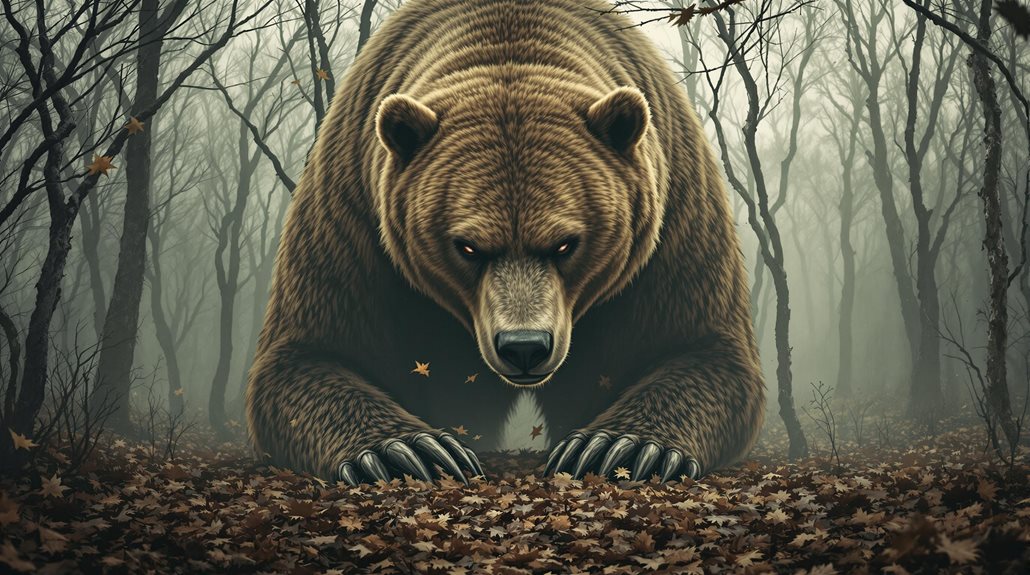The term "bear market" comes from 18th century London's bearskin trade. Merchants called "bearskin jobbers" would sell bearskin pelts before they actually had the bears in hand, betting prices would fall before delivery. This early form of short selling created the metaphor of bears attacking downward, which stuck in financial markets. It's now used when stock prices drop 20% or more from recent highs. The history behind this term reveals fascinating market dynamics.

Panic grips Wall Street during a bear market – a sustained period when stock prices fall by 20% or more from their recent peaks. During these challenging times, investors watch their portfolios shrink while companies report declining earnings, and the overall economy typically slows down.
But have you ever wondered why we call it a "bear" market?
The term "bear market" has an interesting history that dates back to 18th century London's stock market. Back then, merchants known as "bearskin jobbers" would sell bearskins before they actually had the bears in hand. This practice became a metaphor for selling something you don't own yet, which is now known as "short selling" in modern financial markets.
These early traders earned their nickname because they would sell bearskins before actually catching the bears, hoping the price would drop so they could buy the skins later at a lower cost and make a profit. The practice of selling high and buying low became associated with pessimistic traders, who believed prices would fall. That's why we now call a declining market a "bear" market.
The term gained widespread use during the South Sea Bubble of 1720, one of history's most famous financial crashes. The term "bear" also fits well with how bears attack their prey – they swipe their paws downward, similar to how markets move during these periods. This stands in contrast to bulls, which attack by thrusting their horns upward, giving us the term "bull market" for rising prices.
In today's financial world, bear markets are characterized by more than just falling prices. These conditions often persist for a minimum of 2 months. They're often accompanied by increased market volatility, widespread investor pessimism, and a general sense of economic uncertainty. Historical data shows that bear markets experience average losses of 33% during their duration. In cryptocurrency markets, dollar-cost averaging has become a popular strategy for investors looking to capitalize on extended price declines.
These periods typically last for two months or more and can be triggered by various factors, including economic recessions, global crises like pandemics, wars, or the bursting of market bubbles. Market history reveals that there have been 123 market corrections between 1900 and 2013.
During bear markets, investors tend to become more risk-averse, trading activity often decreases, and employment rates may fall as companies struggle with declining profits. While these periods can be unsettling, they're considered a normal part of the market cycle, just like their opposite, bull markets, where prices rise by 20% or more.
Whether you're looking at individual stocks or entire market indices, the bear market term remains a powerful symbol of declining prices and cautious sentiment in the financial world.
Frequently Asked Questions
How Long Does a Typical Bear Market Usually Last?
A typical bear market usually lasts around 9.6 months, or about 289 days. However, they can be much shorter or longer.
The shortest bear markets have lasted just a few months, like the 2020 pandemic crash that lasted only 2 months. The longest one dragged on for 3 years from 1946 to 1949.
It's worth noting that bear markets are typically shorter than bull markets, which average about 2.7 years.
Can Individual Stocks Experience Their Own Bear Market Independently?
Yes, individual stocks can definitely have their own bear markets, separate from what's happening in the broader market.
A stock enters its own bear market when it falls 20% or more from its recent high price. This can happen when a company faces specific problems like disappointing earnings reports, management issues, or industry challenges.
While the overall market might be doing fine, individual stocks can still struggle and experience their own downward trends.
What's the Difference Between a Market Correction and a Bear Market?
The main difference between a market correction and a bear market is how much prices fall and how long the decline lasts.
A correction happens when prices drop 10-20% from recent highs and usually lasts a few months.
A bear market is more severe, with prices falling more than 20% and typically lasting around 10 months.
While corrections often stem from short-term events, bear markets usually reflect deeper economic problems.
Do Bear Markets Always Lead to Economic Recessions?
Bear markets don't always lead to economic recessions. Historical data shows that only 9 out of 16 recorded recessions happened alongside major stock market declines.
While bear markets and recessions often go together, they're separate events. Sometimes stocks can drop sharply without the broader economy falling into recession.
In fact, 12.5% of recessions have actually seen stock market gains, showing that the link between markets and the economy isn't guaranteed.
Which Sectors Tend to Perform Better During Bear Markets?
During bear markets, defensive sectors typically hold up better than others.
Consumer staples do well since people still need to buy food and basic items.
Utilities tend to be stable because everyone needs electricity and water.
Healthcare companies often maintain their business since medical care is vital.
Some investors also turn to precious metals like gold as a safe haven.
These sectors usually have steady cash flows and pay regular dividends.





